Last-Minute NYC Holiday Gift Guide 🎁
We’ve created a holiday gift guide with presents for the intrepid New Yorker that should arrive just in time—


The Theater District in the heart of Manhattan is home to some of the world’s most iconic theaters. The city’s strong theatrical tradition, alive today in the Theatre District and Lincoln Center, dates back to over a century ago. The neighborhood first began attracting theaters and restaurants to the area in 1883 when the Metropolitan Opera House moved to West 39th Street and Broadway. The popularity of the district was further spurred by the installation of the city’s first subway line in 1904, and theater became more accessible than ever. In the 1920s, the theater district in and around Times Square reached a new record with 264 shows produced in 76 theaters. Today, the area is characterized by towering electronic billboards, flashing lights, and tourist attractions. However, among the flashy modern additions, you can still find historic Broadway theaters still in operation today.
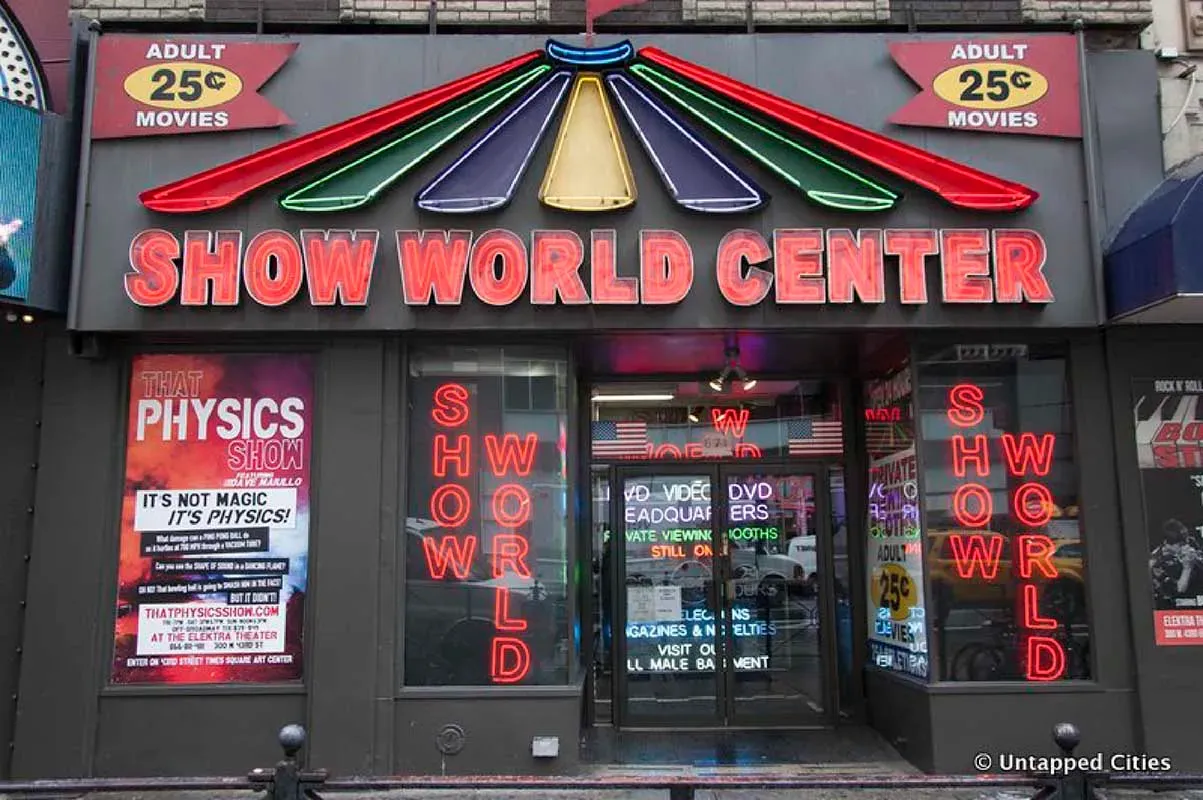
Travel back to when 42nd Street was the Deuce, Eighth Avenue was the Minnesota Strip, the Great White Way was a red light district, and the Crossroads of the World was XXX-rated!
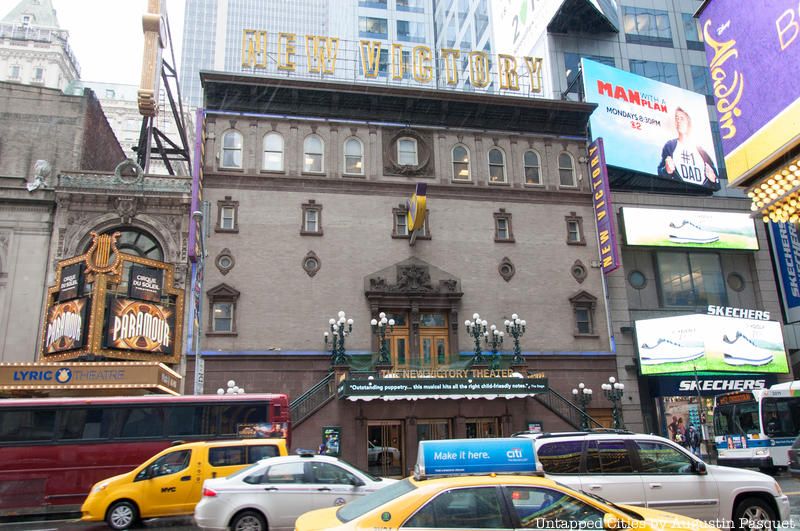
The New Victory Theater, at 209 West 42nd St, was built in 1900 as the Republic Theatre. It was opened by Oscar Hammerstein I, the grandfather of the famous lyricist. Designed by architect J.B. McElfatrick, the theater had a stunning interior featuring marble stairways, carved balustrades, and a gilded dome. An orchestra pit, a modern stage, and new lighting system were later added in the 1920s and even once featured a roof garden. The theater’s facade is identifiable by its grand staircase and ornate lampposts.
In 1931 the theater became Broadway’s first burlesque house, Minsky’s Burlesque, and operated as such until 1941 when burlesque was banned by Mayor LaGuardia. The Republic became a movie theater in the 1940s and adopted the new name, The Victory, in the spirit of World War II. The theater most notably (and scandalously) showed pornographic films in the 1970s, the first theater to do so in the area. It was the only XXX porn house on 42nd Street at a time when Times Square was a gritty hub of vice and crime. Learn more about Times Square’s seedy past on our upcoming tour of the Remnants of Gritty Old Times Square!
In 1995, The New Victory became the first theater on 42nd Street to be renovated as part of the revitalization of the area. The theater is now run by The New 42nd Street as a non-profit that puts on plays year-round for young audiences. The New Victory Theater received a special Drama Desk Award in 2012 for “providing an enchanting, sophisticated theater that appeals to the child in all of us, and for nurturing a love of theater in young people.”
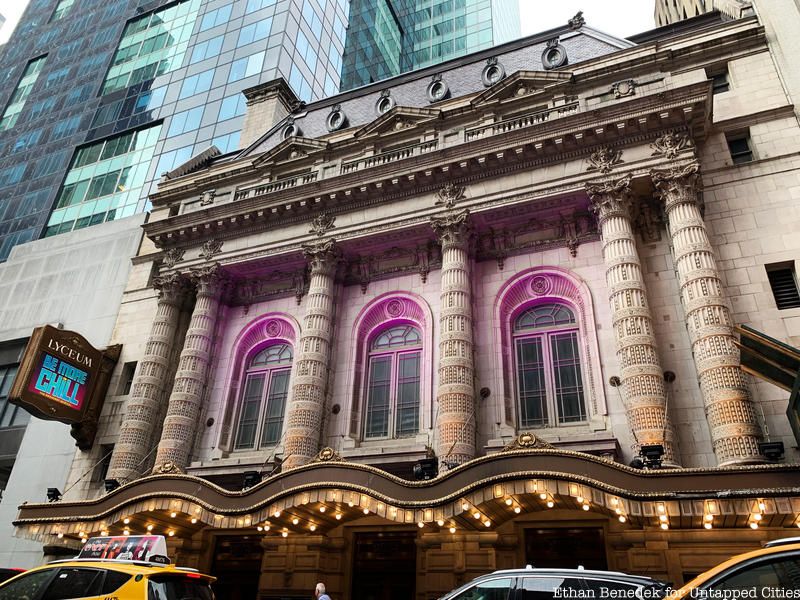
The Lyceum Theatre is Broadway’s oldest and most historic theater. It opened in 1903 with its first show, “The Admirable Crichton,” and is still in operation today, currently running the show “Be More Chill.” The Lyceum was built by theatrical producer David Frohman and his brother Charles. David lived in an apartment above the auditorium. The penthouse apartment had a small view of the stage from which Frohman would wave a white handkerchief to signal to his wife, Margaret Illington, that she was overacting. The theater was designed in a Beaux-Arts style as many Broadway theaters of its era were. The design features a gray limestone facade, fluted columns, large French windows, a mansard roof, and a wide frieze engraved with theatrical masks.
The theater has been owned by the Schubert organization since 1954 and was the first Broadway theatre to be granted landmark status in 1974. The Lyceum Theatre is one of the few Broadway theaters to operate under its original name. Other notable productions to premiere at the Lyceum include “Liza with a Z” (1972), “Steel Magnolias” (2005), and “Oh, Hello” (2017).
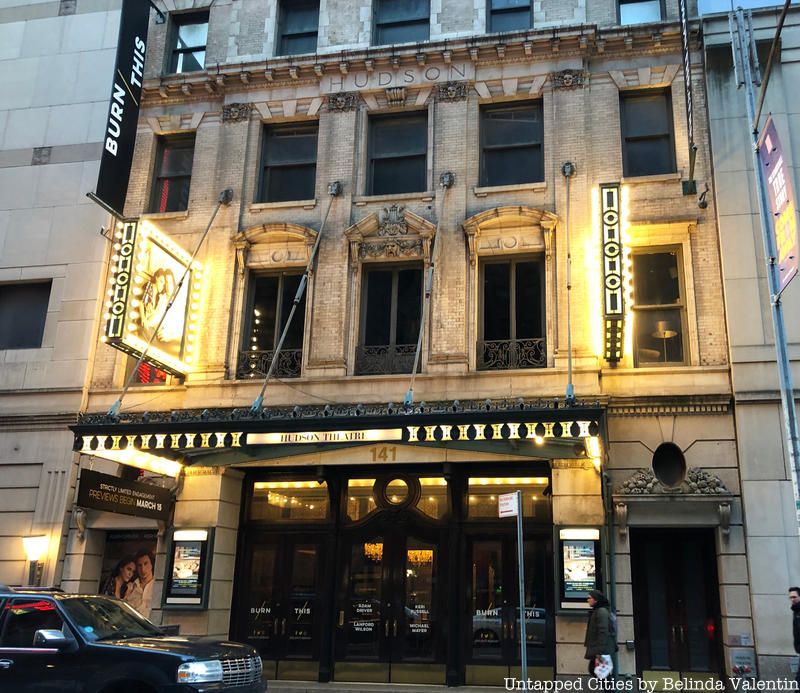
The Hudson Theatre is among the oldest Broadway theaters in the city, opening in 1903. It was built by Henry B. Harris who later tragically died in the 1912 sinking of the Titanic. Its first production was “Cousin Kate” and it is currently home to the play “Burn This.” At the time of its construction, the theatre had a 100-foot-long lobby and a backlit stained glass ceiling made by Tiffany. The interior of the theater also features classical plaster ornamentation and concealed lighting effects.
Though it currently operates as a theater as it was originally intended, the building has served several purposes over the years. In the 1930s and 40s, the Hudson was a CBS radio studio in between productions. From 1953-1959 the building was home to “The Tonight Show” with host Steve Allen and later Jack Paar. In 1974 the theater reopened as a movie cinema for adult films. Finally, in 2015, the building was converted back into a Broadway theater, opening in 2017 with a revival production of Sondheim’s “Sunday in the Park with George.” The theater was granted landmark status in 1987.
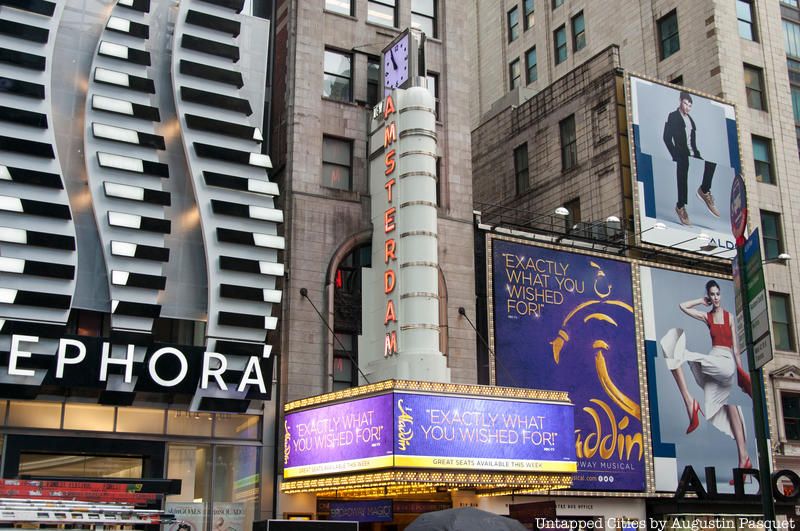
Along with the Lyceum Theatre and the Hudson Theatre, The New Amsterdam Theatre is among the oldest in New York, opening in 1903. At the time of its construction, the New Amsterdam was the largest Broadway theater with 1,702 seats. The venue was also built to incorporate two performance spaces within an additional office tower. The New Amsterdam is a rare example of Art Nouveau architecture in New York, meant to express the spirit of drama. Its first production was Shakespeare’s “A Midsummer Night’s Dream.” In 1904, the Roof Garden, which no longer exists, was added where more risqué productions were presented.
The New Amsterdam Theatre was the home of the Ziegfeld Follies from 1913 to 1927. Owner Florenz Ziegfeld operated a nightclub on the roof. It was first used as a movie theater during the Great Depression in 1937, a time when many Broadway theaters had to resort to showing films in order to stay in business. It remained a movie theater until 1985 when the building was obtained by Disney Theatrical Production as the flagship theater for Walt Disney productions on Broadway. Its current production is Disney’s “Aladdin,” which opened in 2014. The building was made a historical landmark in 1979.
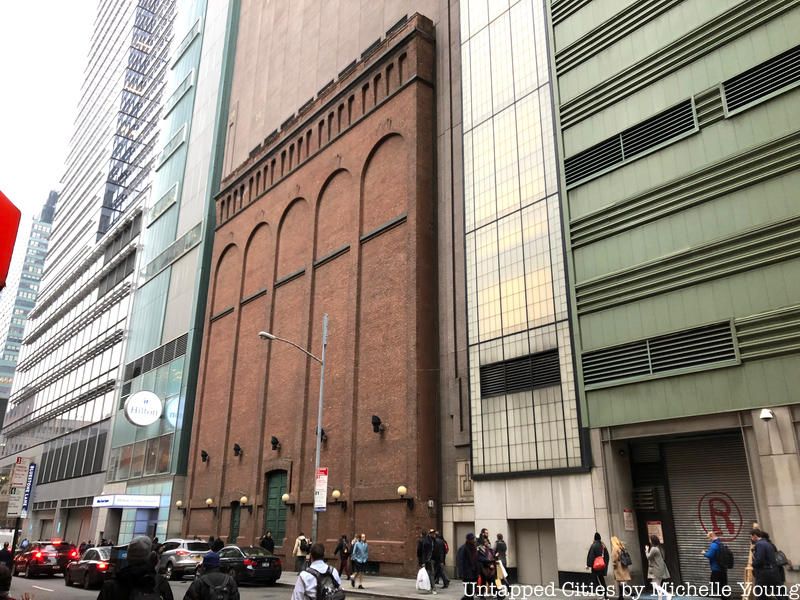
Though the venue is no longer used as a Broadway theater, The Liberty Theatre was among the first professional theaters to operate on Broadway. The theater was built in 1904 in a Beaux-Arts style designed by Klaw and Erlanger. The design featured a Neo-Classical inspired facade, which included a 100-foot-long lobby entry, a set of caryatides by the main entry, and a large arched window below a carving of the Liberty Bell. The auditorium, which held over 1,000 seats, also featured Liberty Bells and eagles circling the dome ceiling and the proscenium arch.
The Liberty Theatre only remained a Broadway theater until 1933 when it was converted to a movie theater, and remained as such until 1996. By then, much of the original Beaux-Arts architecture had been removed and remodeled. A staged reading of T.S. Elliot’s “The Waste Land” was produced at The Liberty but closed shortly after its opening. After years of vacancy, the foyer was remodeled as a restaurant where a bar currently operates and the auditorium is used for special events. A few lucky guests got to see inside the auditorium in 2015 as The Liberty Theater was the setting of Ziegfeld Midnight Frolic, a unique immersive performance created by artist and author Cynthia von Buhler of Speakeasy Dollhouse. It was most recently the venue of a haunted attraction which closed in 2022.
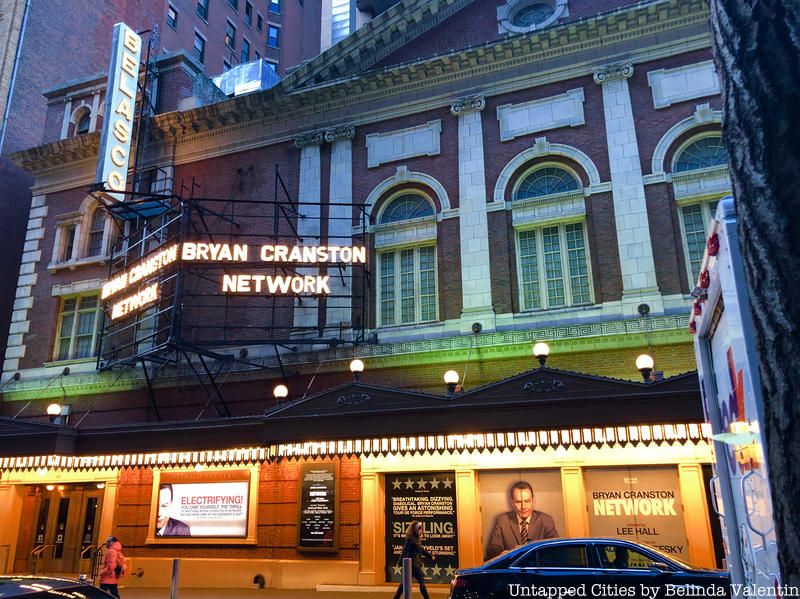
The Belasco Theatre, which opened in 1907, was intended to house “living room plays” according to its namesake David Belasco, theatrical producer, director, and playwright. Therefore, the audience seats are intended to be as close to the actors as possible. The building’s design displays a fusion of Churrigueresque, Spanish Renaissance, Moorish, and Gothic architecture. Much of its original details have survived including its striking dome ceiling. Today, the theatre seats just over 1,000. In its early days, the theater was among the more advanced with its complex lighting board even in the early days of electricity.
The theater is believed to be haunted by the ghost of David Belasco, though rumor has it the spirit was driven away with the theater’s 1971 production of “Oh! Calcutta!”. Supposedly the promiscuity of the show caused the ghost of the theater’s namesake to stop appearing. Another claim to fame of the Belasco Theatre is actor Marlon Brando’s first widely acclaimed success in a 1946 production of Maxwell Anderson’s “Truckline Cafe.”
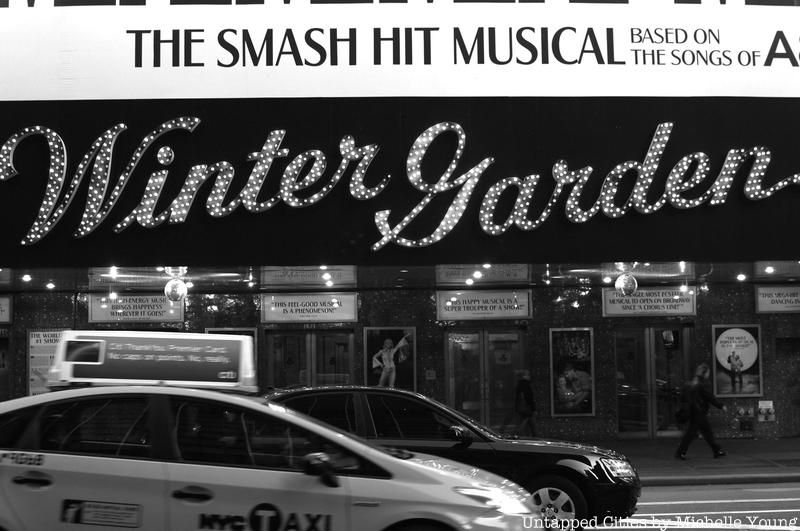
The Winter Garden Theatre has been reconfigured multiple times in its history. In 1911 the Shuberts purchased the second American Horse Exchange building, a structure built in 1896 by William K. Vanderbilt when Times Square, then known as Longacre Square, was the center of the horse and carriage industry. The Shuberts had architect William Albert Swasey convert the building into a theater, and it was later remodeled in 1922, so pieces of the original structure still remain. Its first show was a production of “La Belle Paree” starring Al Jolson, who rose to stardom after that production. The Winter Garden is currently home to “Beetlejuice.”
The theater’s longest-running production was “Cats” which ran from 1982 until 2000, making it the fourth longest-running Broadway show of all time. The auditorium was remodeled and essentially gutted in 1982 specifically for “Cats” to accommodate the production’s junkyard setting. When “Cats” closed in 2000, the theater was restored to its original 1920s model which features a stage wider than most Broadway stages, and a relatively low proscenium arch. Notable productions to premiere at the Winter Garden Theatre include “West Side Story” (1957), “Funny Girl” (1964), “Gypsy” (1974), and “Mamma Mia!” (2001).
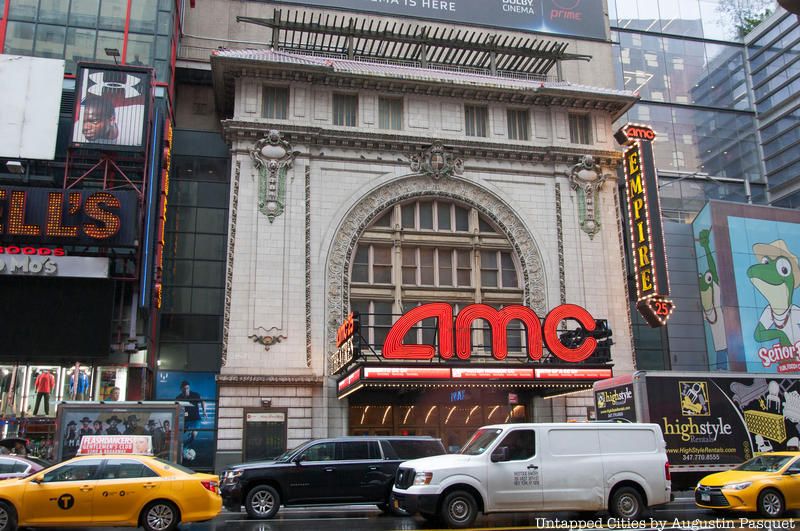
The AMC 25 Times Square movie theater was originally a Broadway theater. The theater was built by Al Woods and originally named after impersonator Julie Eltinge. From 1912 to 1931 the venue specialized in showing light comedies including its first production of “Within the Law” in 1912.
During the Great Depression, the theater suffered and became a burlesque theater, then a movie theater in 1942. The venue was renamed the Empire Theatre in 1954. The theater closed in 1986 and was then relocated in 1998. The building was lifted off the ground and moved 170 feet away from its former location on 42nd Street and transformed into the AMC movie theater, reopening in 2000. The 3,700-ton structure was converted into the entrance lobby, and much of the original architecture of the auditorium remains in the entranceway. Due to its expensive alterations, this building was removed is not eligible for landmark consideration.
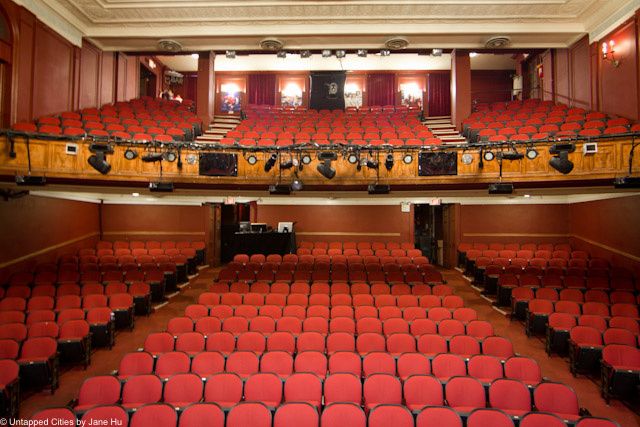
The Helen Hayes Theatre originally opened as the Little Theatre in 1912. With only 599 seats, it is the smallest theater on Broadway. The first show to run in the theater was a production of “The Pigeon.” The building was sold to The New York Times in 1931 and converted into a conference hall. In the 1950s, it was used as a recording studio for television and radio.
In 1983, the building was bought back as a theater by producers Martin Markinson and Donald Tick and renamed for Helen Hayes, known as the First Lady of the American Theatre. Another theater in her name had been demolished. Look for her footprints in front of the entrance lobby. Designated a landmark in 1987, the theater bears a combination of formal Classical and Beaux-Arts design. Currently running at the Helen Hayes Theatre is “What the Constitution Means to Me.” Other notable productions include “Romance/Romance” (1988), “Rock of Ages” (2011), and “The Humans” (2016).
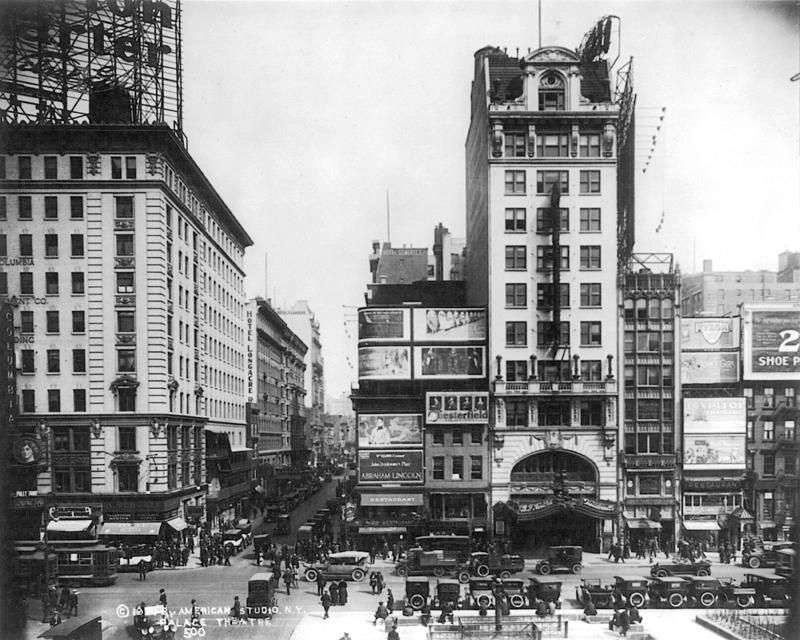
Unlike many of the Broadway theaters, The Palace was specifically and originally designed to house vaudeville. Construction began in 1912 at the behest of West-Coast showman and entrepreneur Martin Beck. The theater, along with connected office space, was elaborately designed by Midwest theater architects Kirchhoff & Rose. It was renowned for its fine acoustics and inside featured a double-balconied auditorium, boxes, and loges on three levels. Its design also included an unusually high and wide proscenium arch, a large stage, and a lavishly baroque foyer and lobby filled with high-relief plasterwork, marble, and ironwork.
In 1932, under economic pressure from movie theaters popping up around it, the Palace turned into a mixed vaudeville and film house. This required modifications to the architecture and much of the elaborate decor was covered up over the next few decades. The theater was purchased by the Nederlanders in 1965 and a half a million dollar restoration project revealed the theater’s original decor. They even found crystal chandeliers in the basement which now hang in the lobby. Theatrical productions returned to The Palace thanks to the Nederlanders and continued to run until 2018 when “Spongebob Squarepants: The Musical” closed in preparation for the theater’s integration into the new TSX Broadway building. The landmarked interiors will remain intact and be restored as the theater is lifted thirty feet. Notable Broadway shows that have been in the Palace include “Beauty and the Beast,” “Aida” and Judy Garland’s record-breaking nineteen-week performance.
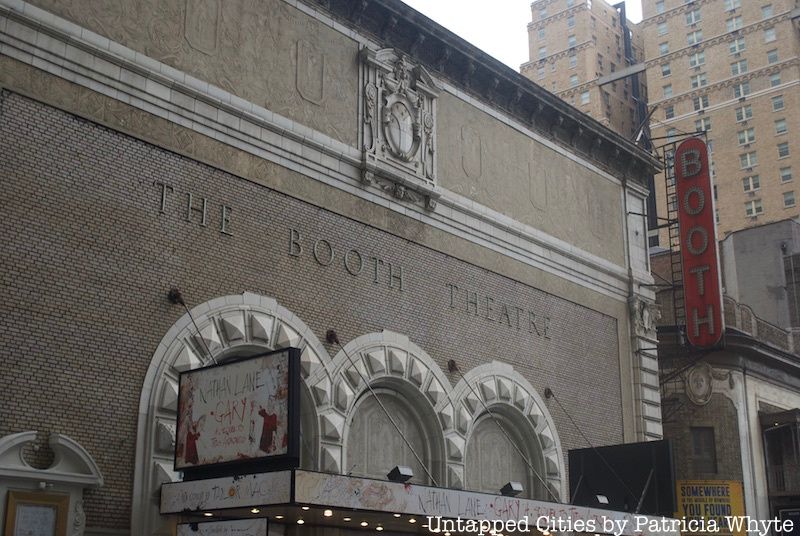
The Booth Theatre was designed as a back-to-back pair with the Shubert Theatre. Though the two have completely different interiors, the Broadway theaters share a Venetian Renaissance facade. The venue was built from scratch in 1913. The first show to open at the Booth Theatre was a 1915 production of “Our American Cousin.” The theater’s 783-seat auditorium is considered small for Broadway theaters. The intent was to provide an intimate setting for dramatic and comedic plays.
The theater was named in honor of the 19th-century actor Edwin Booth, brother of Abraham Lincoln’s assassin John Wilkes Booth. Currently showing at the Booth Theatre is “ Gary: A Sequel to Titus Andronicus,” starring Nathan Lane. Other notable premieres at the Booth Theatre include “You Can’t Take It With You” (1936), “Once on This Island” (1990), “Next to Normal” (2009) and “Hand to God” (2015).
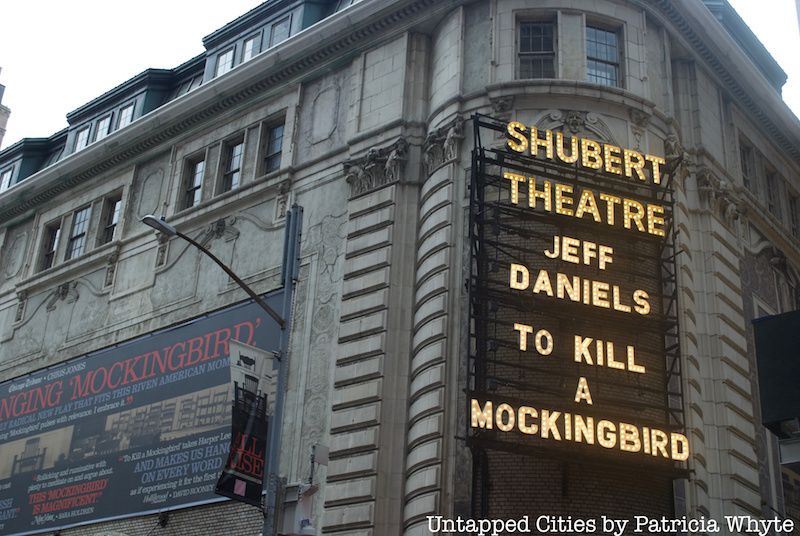
The Shubert Organization obtained this building in 1911 and architect William Albert Swasey redesigned the building as a theater alongside the Booth Theatre. The building was named after Sam S. Shubert, American producer and second oldest of the Shubert family. The building design features a Venetian-inspired facade, furnished with sgraffito ornament. The Shubert and Booth are connected by a private road, Shubert Alley, which is connected to the Times Square Theater.
The first show to open at the Shubert Theatre was a 1913 production of Shakespeare’s “Hamlet.” The top floor of the building houses the offices of the Shubert Organization. The theater’s auditorium was restored in 1996 and has been designated a New York City landmark. The Shubert Theatre has been a recurring venue for the Tonys, though in recent years the event has taken place in Radio City Music Hall. The venue was also featured in the 1950 Academy Award-winning film “All About Eve.” Currently playing at the Shubert Theatre is “To Kill a Mockingbird”.
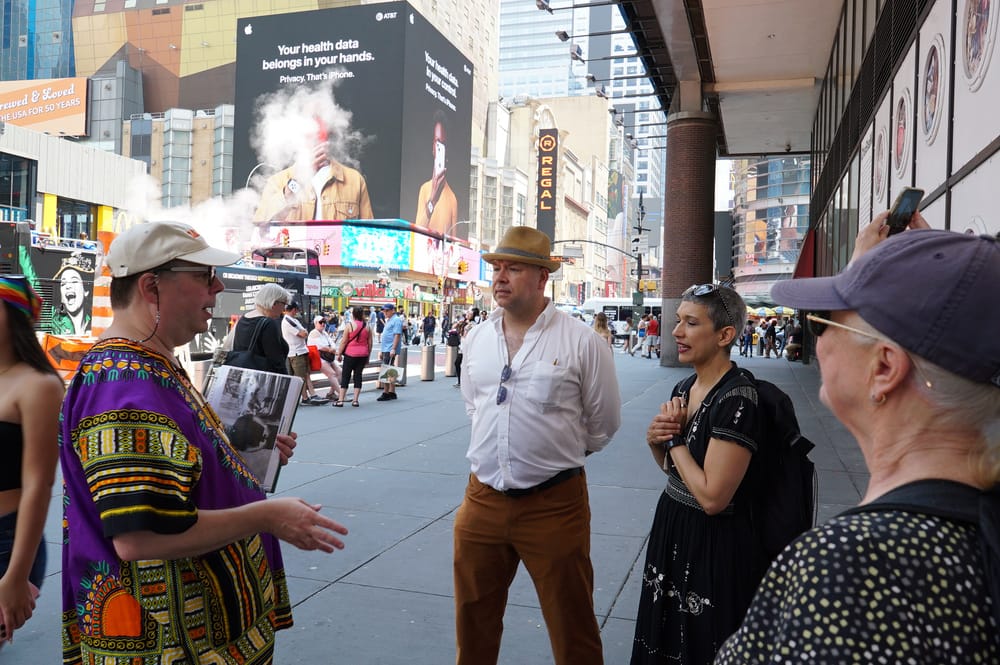
"Take this tour before the old Times Square completely disappears. Robert is very well informed and has a wealth of information about the old and new Times Square. MUST SEE!" - Gildo from Astoria, TripAdvisor
Next, check out 15 of NYC’s Lost and Demolished Grand Theatres
This article was written by Patricia Whyte
Subscribe to our newsletter